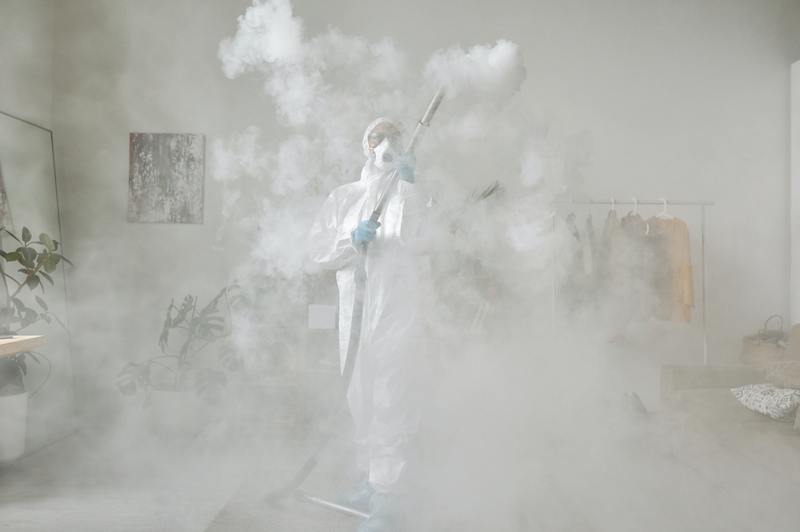When you need pest control to pay a visit, you may be wondering what is fumigation in pest control. Your home will be dealing with heavy fumes to get rid of those pesky critters so let’s walk you through the process.

What Is Fumigation?
In a nutshell, fumigation is a process wherein pest control services release a special type of gas throughout the home. This procedure can be highly effective in suffocating and poisoning pests that contaminate hard-to-reach areas.
It’s important to note that the smoke pest control uses are extremely toxic to any living organism which also includes humans and pets. You can expect you and your family to be out of the house for extended periods when they implement the fumigation process.
What Are The Methods Of Fumigation?
There are different ways pest control conducts fumigation, and sometimes it’s not purely smoke.
1. Gas fumigation
This is perhaps the most common type of fumigation. As the name implies, the fumigants take on a smoky, gaseous form.
When this type of fumigation is carried out, the home is enclosed and gas-proofed. This procedure, often called “tenting”, is the reason you see fumigated houses covered in tents.
They do this to ensure that toxic fumes don’t affect the environment outdoors.
2. Solid fumigation
This type is easier for pest control to use and a little safer than gas fumigants.
What pest control does here is they scatter pellets, tablets, or powder in specific amounts. Some certain types of solid fumigants, such as calcium cyanide, can react with water vapor to efficiently get rid of pests.
3. Liquid fumigation
This type is similar to spraying methods usually employed by pest control.
In this process, pest control sprays liquid chemicals all over affected and possibly infested areas. These liquids work faster than other types of fumigants.
In some cases, the liquid chemicals can also deal with mold.
How Different Are Pest Control and Fumigation?
Fumigation is, no doubt, part of pest control, but it is just one part of what pest control does.
General pest control simply deals with controlling and managing regular pest occurrences. This service can involve regular visits every few months to inspect your home and apply preventative measures.
If you’re thinking of having routine visits from pest control, here’s a detailed article on how often should pest control be done.
Fumigation, on the other hand, is a more extreme form of pest control. They’ll use thick gases and other chemicals to get rid of commodity pests.
These kinds of pests contaminate and feed on, as the name implies, commodities, other perishable goods, furniture, or parts of your home’s structures. They can be either termites or various species of beetles that can affect the structural integrity of your home.
Due to the strong chemicals that they apply and spread about, regular visits from your pest control company don’t warrant fumigation. They usually reserve this for more severe infestations, especially if it’s commodity pests.
How Do You Go About Fumigation When The Need Arises?
As extreme as this measure may be, you’ll need to resort to fumigation when infestations reach critical levels. You’ll have to prepare for questions by your pest control company before they start fumigating.
One of the things they’ll ask is if they should be aware of conduits, vacuum systems, drains, or other structural elements. These elements let them know if fumigants can spread to neighboring structures.
Once they start fumigating, you can expect time away from your home to from 24 to 72 hours. The factors that determine wait time are the severity of the infestation, dosage measurements, size of the structure, temperature, or anything else that pest control needs to handle.
After pest control gives the OK signal to come back home, it’s important to open your windows and keep the home ventilated. There may be some residual vapors even when things are OK, so best to be careful.
It’s important to note that like other pest control procedures, fumigation doesn’t have a 100% guarantee of eliminating all vermin.
There may be areas where the chemicals didn’t reach, such as underground tunnels. You may notice signs of pests coming back after some time passes.
This doesn’t mean it was a failure, although the previously mentioned regular visits can help manage the spread before a full-on infestation reappears. This doesn’t necessarily warrant another fumigation process but rather routine follow-up spot treatments.
If you’re wondering what safeguards you need to prepare for before and after fumigation for pest control services in general, here’s a handy guide detailing how does pest control work.
Conclusion
Fumigation is usually in the event of a worst-case scenario. You don’t want things to come to that, but it can often be the necessary step to deal with nasty infestations.
Now that you know what is fumigation in pest control, you’ll have a better understanding of what to expect. You’ll be in a better headspace with this information in mind when you think a pest situation calls for fumigation.
You don’t have to worry as fumigation will help your home become healthier and happier!
